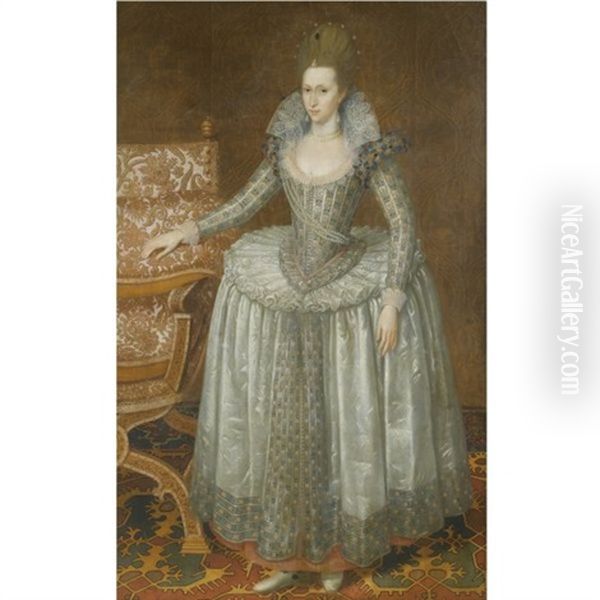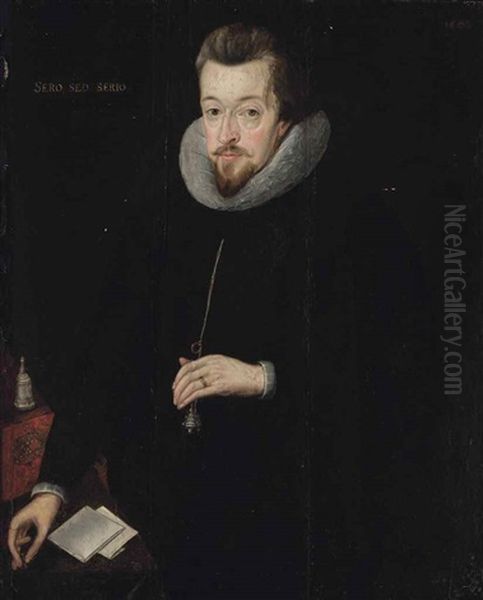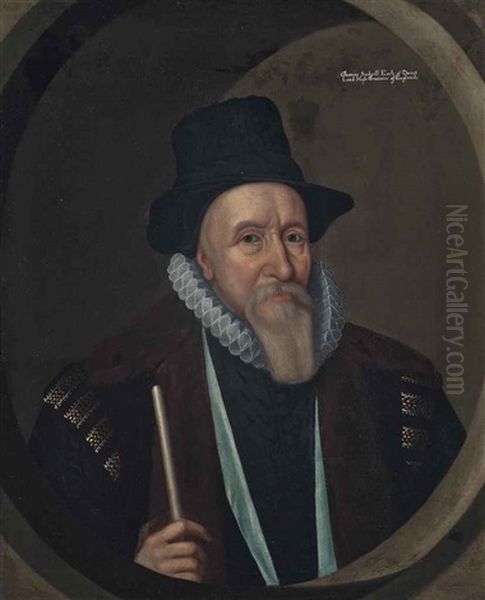John de Critz the Elder stands as a significant, if sometimes overlooked, figure in the landscape of English art during the late Tudor and early Stuart periods. A Flemish émigré who rose to the esteemed position of Serjeant Painter to both Queen Elizabeth I and King James I, de Critz played a crucial role in shaping the visual culture of the English court. His career spanned a transformative era, witnessing shifts in artistic taste, patronage, and the very function of art within the monarchy. Understanding his life and work offers a window into the complex interplay of continental influences and native traditions that defined English painting at the turn of the 17th century.
Netherlandish Roots and Arrival in England
Born around 1551 or 1552, likely in Antwerp, John de Critz (also spelled Decritz, de Creete, or de Critzs) hailed from a family with artistic inclinations. His father, Troilus de Critz, was a goldsmith, a profession often closely allied with the visual arts in terms of craftsmanship and design. The religious turmoil of the Low Countries, particularly the persecution of Protestants by the Spanish Habsburg rulers, led many skilled artisans and intellectuals to seek refuge elsewhere. It is believed that the de Critz family, being Protestant, fled Antwerp for England around 1568, when John was still a teenager. This exodus brought a wealth of talent to England, enriching its cultural and artistic fabric.
Upon arriving in England, the young John de Critz is thought to have been apprenticed to another Netherlandish artist, Lucas de Heere. De Heere, himself a refugee, was a painter, poet, and antiquarian who had established a successful practice in England, patronized by figures such as Lord Burghley. This apprenticeship would have provided de Critz with a solid grounding in the Netherlandish portrait tradition, characterized by meticulous detail, a strong grasp of likeness, and often, a rich symbolic vocabulary. The artistic environment in London at this time was heavily dominated by immigrant artists from the Low Countries, who brought with them a level of technical skill and stylistic sophistication that was highly sought after by English patrons.
Early Career and the Path to Royal Service

By the late 1570s or early 1580s, John de Critz appears to have established himself as an independent painter. His skills would have been employed in producing portraits, a genre of immense importance in Elizabethan England for conveying status, lineage, and political allegiance. While concrete attributions from his earliest period are scarce and often debated, it is clear he was building a reputation. His Netherlandish training would have equipped him to work in various formats, from full-length portraits to smaller panel paintings.
His connection to the court likely developed through networks of patronage and perhaps through his association with other established court artists. The Office of the Revels, responsible for court entertainments, frequently employed painters for decorative work, and this may have provided an avenue for de Critz. His talent did not go unnoticed, and he began to receive commissions that brought him closer to the royal circle. One of his significant early patrons was Sir Francis Walsingham, Queen Elizabeth I's principal secretary and spymaster. A portrait of Walsingham, dated around 1589 and attributed to de Critz, showcases the artist's ability to capture a sitter's gravitas and intellectual presence, rendered with the detailed precision characteristic of the Netherlandish school.
The Esteemed Role of Serjeant Painter
The pinnacle of a court artist's career in England was the appointment to the office of Serjeant Painter. This was not merely an honorary title; it was a salaried position with a wide range of responsibilities. John de Critz the Elder achieved this distinction, being appointed Serjeant Painter to King James I in 1603, a position he would hold until his death. Some sources suggest he may have held a similar, if perhaps less formally defined, role under Elizabeth I towards the end of her reign, possibly sharing responsibilities with George Gower, who was Serjeant Painter from 1581 until his death in 1596.

The duties of the Serjeant Painter were extensive and varied. While portraiture of the monarch and the royal family was a key component, the role encompassed a much broader scope of artistic and decorative work. The Serjeant Painter was responsible for the decoration of royal palaces, including painting interiors, architectural features, and even furniture. They designed and executed ephemeral decorations for court masques, tournaments, and other festivities – elaborate painted banners, scenery, and props. The painting of royal barges, coaches, and heraldic insignia also fell under their purview. This required not only artistic skill but also considerable organizational ability, as the Serjeant Painter often managed a workshop of assistants and apprentices to fulfill these diverse commissions. Leonard Fryer was appointed alongside de Critz in 1605, and later, Robert Peake the Elder also shared the office, reflecting the substantial workload.
Patronage under Queen Elizabeth I
During the reign of Elizabeth I, English portraiture was characterized by a strong emphasis on symbolism, elaborate costume, and a somewhat hieratic, iconic representation of the monarch. While direct evidence of de Critz's specific commissions from Elizabeth herself is not always clear-cut, his involvement in court circles during the latter part of her reign is well-established. He would have been working alongside prominent artists like Nicholas Hilliard, the Queen's limner (miniaturist), and George Gower.
The style prevalent at the Elizabethan court, often referred to as the "Cult of Elizabeth," demanded images that projected majesty, virtue, and imperial power. Artists like de Critz, with their Netherlandish training, were adept at rendering the intricate details of jewels, lace, and embroidered fabrics that were so crucial to these displays of magnificence. While Hilliard excelled in the intimate art of the miniature, painters like de Critz and Gower were responsible for larger-scale oil portraits that adorned the galleries of palaces and noble houses. The influence of visiting artists, such as the Italian Federico Zuccaro, who briefly worked in England in 1575, also contributed to the evolving stylistic trends.
Flourishing under King James I and Anne of Denmark
The accession of James I in 1603 marked a new era of patronage, and John de Critz was well-positioned to benefit. His formal appointment as Serjeant Painter (initially jointly with Leonard Fryer) solidified his status. The Jacobean court, while still valuing display, perhaps fostered a slightly less overtly symbolic and more naturalistic approach to portraiture, though the emphasis on regal dignity remained paramount. De Critz, along with his workshop, was responsible for producing numerous portraits of the King, his consort Anne of Denmark, and their children, notably Henry, Prince of Wales, and Princess Elizabeth.

One of the most famous images associated with this period is the full-length portrait of James I, dated around 1605, now in the collection of the Hispanic Society of America, New York, which is attributed to de Critz. This painting, and others like it, served as official images of the monarch, disseminated to embassies, loyal subjects, and foreign courts. Anne of Denmark was also a significant patron of the arts, particularly of masques, and de Critz would have been heavily involved in the elaborate scenic designs for these lavish court entertainments, working alongside figures like Inigo Jones. The demand for royal imagery was high, and artists like de Critz, Marcus Gheeraerts the Younger, and later, Paul van Somer and Daniel Mytens, catered to this need.
Artistic Style and Characteristics
John de Critz's artistic style is rooted in the Netherlandish tradition, emphasizing detailed realism, careful rendering of textures, and a strong sense of draftsmanship. His portraits typically feature a meticulous attention to costume, capturing the richness of fabrics, the glint of jewels, and the intricacies of lace. This was not mere ostentation; in the hierarchical society of the time, clothing and accessories were powerful signifiers of status, wealth, and identity.
Compared to some of his English contemporaries, de Critz's figures often possess a greater sense of three-dimensionality and a more nuanced psychological presence, though they generally adhere to the formal conventions of court portraiture. His palette could be rich and varied, and his handling of paint, while precise, could also achieve a certain fluency. However, the collaborative nature of workshop production in this period, especially for a busy Serjeant Painter, means that the hand of assistants is often present in works emerging from his studio. This makes definitive attributions challenging, and art historians continue to debate the authorship of many portraits from this era. His work can be seen as a bridge between the more linear, decorative style of earlier Tudor painting and the burgeoning Baroque influences that would become more prominent with artists like Van Dyck later in the 17th century.
Representative Works and Attribution Challenges
Attributing specific works solely to John de Critz the Elder can be complex due to several factors: the collaborative nature of his workshop, the loss of many records, and the stylistic similarities among artists working in the same milieu. However, several key portraits are generally accepted as being by him or his studio.
The aforementioned Portrait of Sir Francis Walsingham (c. 1589, National Portrait Gallery, London) is a strong candidate from his earlier career. From the Jacobean period, the Portrait of James I (c. 1605, Hispanic Society of America) is a significant example of his royal portraiture. Another notable work often attributed to him is the Portrait of James I in Parliament Robes (c. 1610, Loseley Park). He is also believed to have painted Anne of Denmark and Henry, Prince of Wales, though specific attributions can vary. For instance, a full-length portrait of Henry, Prince of Wales, with a Lance (c. 1603, Parham Park) is sometimes given to de Critz.
Beyond formal portraits, much of de Critz's work as Serjeant Painter was decorative and, by its nature, ephemeral. This includes the painting of the royal tombs in Westminster Abbey, such as the tomb of Elizabeth I and the tomb of Mary, Queen of Scots, where he was responsible for the gilding and painting of the effigies and structures designed by others. He also undertook extensive decorative work at royal residences like Oatlands Palace and Theobalds House. Unfortunately, a great deal of this decorative work has not survived, leaving us with an incomplete picture of his full artistic output.
Contemporaries and the Artistic Milieu
John de Critz operated within a vibrant and competitive artistic scene in London. He was one of several talented Netherlandish émigrés who dominated large-scale oil painting. Marcus Gheeraerts the Younger was a prominent contemporary and, in many ways, a friendly rival. Both artists shared a similar background and catered to the same elite clientele, and their styles can sometimes be difficult to distinguish. Robert Peake the Elder, who also became Serjeant Painter, was another key figure, known for his portraits of aristocratic families and his involvement in painting banners for the Earl of Essex's military campaigns.
While de Critz focused on large-scale works, the influence of miniaturists Nicholas Hilliard and Isaac Oliver was pervasive. Their exquisite, jewel-like portraits set a high standard for capturing likeness and conveying status, and their aesthetic undoubtedly informed the broader field of portraiture. William Larkin, active slightly later in the Jacobean period, developed a distinctive, highly decorative style characterized by flat, patterned rendering of costume, often referred to as the "Jacobean masque" style.
Other Netherlandish artists active in England during or around de Critz's time included Cornelis Ketel, who worked in England from 1573 to 1581 before returning to Amsterdam, and later arrivals like Paul van Somer (from c. 1616) and Daniel Mytens (from c. 1614). These artists brought with them evolving continental styles, gradually introducing a more Baroque sensibility that would eventually supersede the more linear and detailed approach of de Critz's generation. The presence of these artists created a dynamic environment of exchange and competition, pushing the boundaries of English court art. George Gower, as the preceding Serjeant Painter, also set a precedent for the role that de Critz would inherit and expand upon. Rowland Lockey, a pupil of Hilliard, also produced some notable large-scale group portraits.
The De Critz Family Workshop and Legacy
Like many artists of his time, John de Critz the Elder maintained an active workshop. This was essential for managing the diverse and numerous commissions that came with the office of Serjeant Painter. His sons, John de Critz the Younger, Thomas de Critz, and Emmanuel de Critz, all became painters and likely trained and worked within the family studio. John the Younger eventually succeeded his father in the office of Serjeant Painter, continuing the family's tradition of service to the Crown. Thomas de Critz is recorded as working on decorative schemes for masques and palaces, while Emmanuel was also active as a painter.
This familial and workshop-based system of artistic production was common and ensured the transmission of skills and styles across generations. It also complicates attributions, as it can be difficult to discern the individual contributions of father and sons, or other assistants, within the workshop's output.
John de Critz the Elder died in London on or before 14 March 1642, the date his will was proven. He had lived a long and remarkably successful life, navigating the complexities of court politics and artistic trends for over four decades. His legacy lies in his significant contribution to the visual culture of the English court during a pivotal period. He helped to solidify the Netherlandish influence on English portraiture while adapting to the specific tastes and requirements of his royal and aristocratic patrons. As Serjeant Painter, he was more than just a portraitist; he was a master craftsman and administrator responsible for the visual splendor of the monarchy.
Conclusion: An Enduring Influence on English Art
John de Critz the Elder remains a key figure for understanding the art of Elizabethan and Jacobean England. His career exemplifies the vital role played by immigrant artists in enriching English culture. Through his long tenure as Serjeant Painter, he not only produced a significant body of work (much of which is, sadly, lost or unattributed) but also helped to define the image of the monarchy for a generation. His meticulous technique, his ability to convey status and dignity, and his versatility in undertaking a wide range of artistic tasks mark him as a master of his craft. While later artists like Van Dyck would introduce a more flamboyant Baroque style to the English court, the foundations laid by de Critz and his contemporaries were crucial in establishing a strong tradition of court portraiture and decorative arts in England. His work, and that of his workshop, provides invaluable visual documentation of the personalities and the cultural preoccupations of a fascinating era in British history.